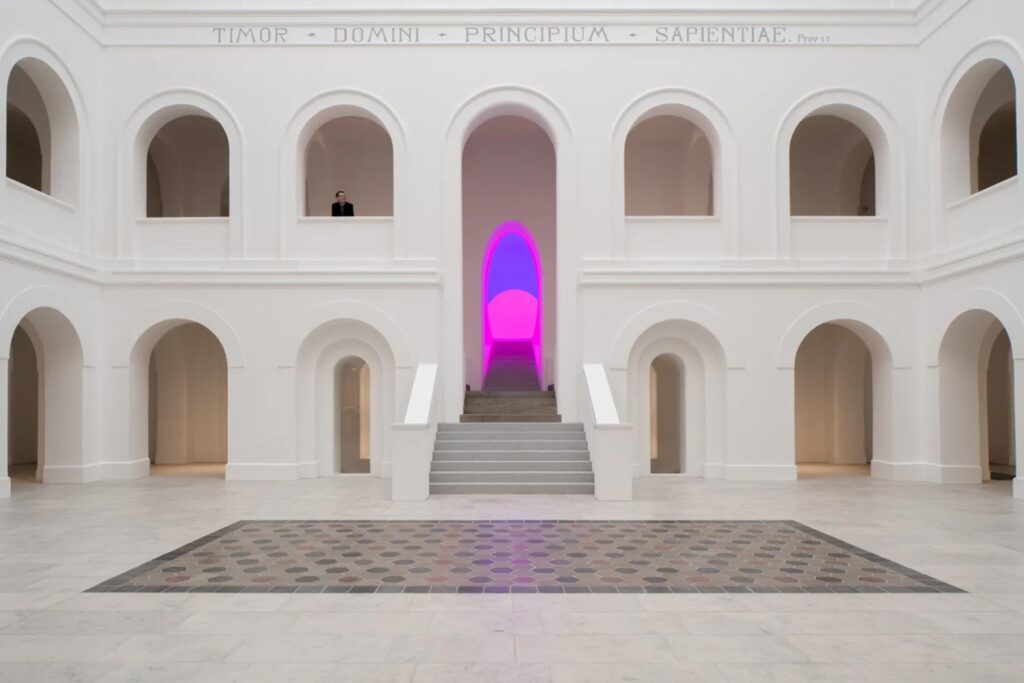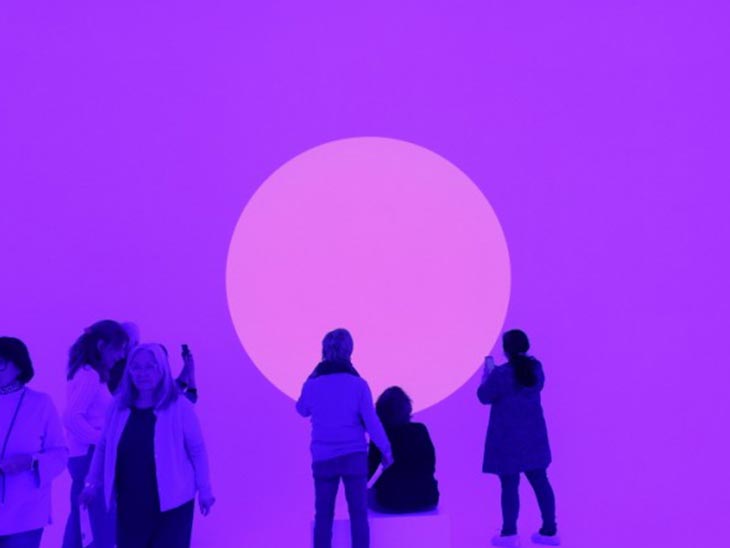
As it approaches its 1 year anniversary, how is light-art heavyweight James Turrell’s permanent installation faring?
Situated in the former house chapel of the new Diocesean musuem in Freising (Bavaria, Germany), this new space takes the form of a cross-room installation that alludes to the most important Byzantine icon in the establishments permanent collection. Interesting meta-data is that both the St. Luke likeness and this new veneration lie in the same visual axis in the building, a press release informs, although one doesn’t really need to be aware of the fact to experience the work in full, it is not conceptual in that sense. Instead, as the visitor will soon find out for themselves, it closely follows the blueprint established across the rest of the artists oeuvre by attempting to quietly relieve the onlooker of any perception of depth, colour, and time, encouraging them instead to slow down and engage with the stage-managed surroundings in a reflective and introspective state.
The chapel fills a vestibule to one side of an internal courtyard, perfectly placed opposite the ticket hall-cum-giftshop. Essentially prefacing the work is the legend: TIMOR DOMINI PRINCIPIUM SAPIENTIAE (Fear of the Lord is the Beginning of Wisdom – an Old Testament phrase attributed to King Solomon) writ large across the areas cornicing. No doubt once intended to keep trainee Priests in line (the building was once a Seminary), the fire and brimstone sentiment seems now somewhat impotent, rendered out of time by Turrell’s contemporary Eccliasticism. The once officious chiselled typography is now simply a rather pleasingvisual compliment to the geometric shapes and diffused colours of the chapels interior that are visible from the outside.
entering the work via its subtle sloping wooden floor is like walking into a Bizarro version of Kapoor’s Descent into Limbo
Elevated above the courtyard by half a storey, the work is entered via a staircase that at first glance looks like a trompe l’oeil, a 2D rendering on the plaster wall, but as one gets nearer it soon becomes clear that they are, indeed, physical and lead up to and through a whitewashed anti-chamber to deliver the visitor into the work proper. Having climbed the steps and passed through an arched entrance, entering the work via its subtle sloping wooden floor is like walking into a Bizarro version of Kapoor’s Descent into Limbo but instead of a light-digesting black hole, here all is bright white lit by ultraviolet light, (coming from a horseshoe of LED strip lighting tracing the locus of the archway with which one has entered the room) but the immediate and disorientating effect is similar – it’s hard to fathom the scale of the thing. Intriguingly, this light source is very clear to see, right down to the seams visible from its construction. It’s more Flavin than Turrell, not only for its plastic qualities but because it looks like something one could buy in the local DIY superstore.
The chapel’s focal point is a large circular aperture opposite to the entrance, inset into which is a smaller flat roundel. The relationship between the two forms is ever-changing due to washes of coloured light from invisible sources; sometimes complimentary; sometimes contrasting – at once there’s a sense of time passing and simultaneously standing still. Situated In front of the large aperture is a small white box, the position of which recalls an altar in front of a rose window although, aside to making an obvious reference to the rooms past purpose, it is only big enough to serve as a useful seat for viewing the show although it has a further use as another tool for disrupting the viewers sense of scale.
These betrayals of construction methods (and perhaps budget) are somewhat unusual for a Turrell work – which usually have a seamless, enigmatic quality
Where the work falls from grace is that unlike an actual chapel, the visitor will most probably share their visit with a Plethora of other punters who, in the event, can’t be relied upon to keep quiet and who, despite having had to don shoe-covers to enter have, over time, rendered proceedings rather grubby. Going further, as one explores the space the wooden floor resonates under foot. The space is therefore not so quiet and contemplative as one imagines the artist might have hoped. These betrayals of construction methods (and perhaps budget) are somewhat unusual for a Turrell work – which usually have a seamless, enigmatic quality that invite a gaze very akin to the way a member of the faithful might look upon a religious icon – not for thematerial qualities but rather for their symbolism. But problems do not matter on the Internet, which is where the work ascends to celestial heights. Multiple visitors have seen fit to souvenir their visit by posting a snapshot on popular image sharing social media platforms. And who could blame them? ‘On screen,’ any problems of the build are disguised, making the work look rather divine indeed.
Despite noble intentions, A Chapel for St Luke ends up feeling more like festivalism than authentic work. In its representation of a representation of a symbol for God’s message on Earth it makes a promise to its congregation that it is art, but it is its popularity rather than its actuality that will be the lasting message.


